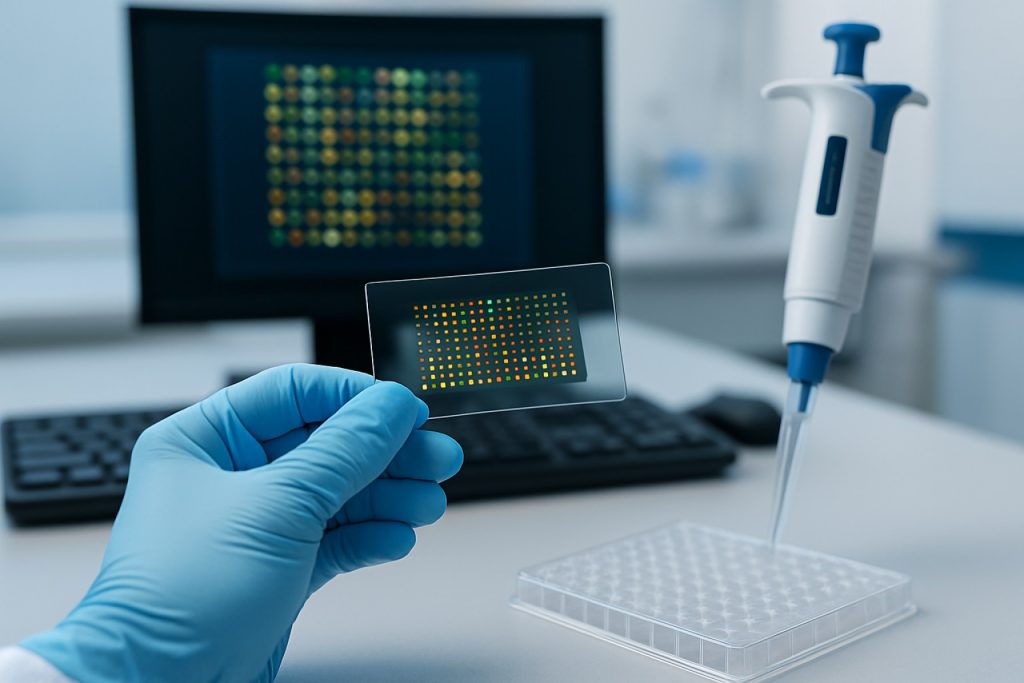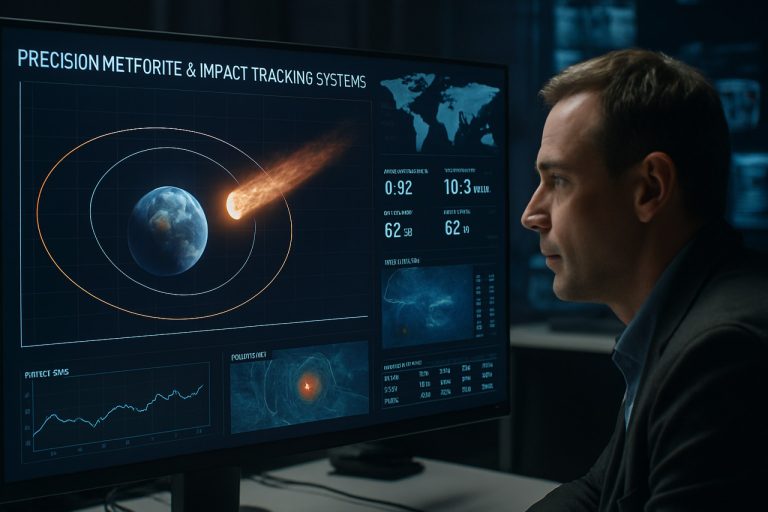
Antigen Microarray Diagnostics in 2025: Transforming Disease Detection with Precision and Speed. Explore the Market Forces, Breakthrough Technologies, and Future Trajectory of This High-Impact Sector.
- Executive Summary: Key Trends and Market Drivers in 2025
- Market Size and Growth Forecast (2025–2030): CAGR and Revenue Projections
- Technological Innovations: Next-Gen Microarray Platforms and Automation
- Competitive Landscape: Leading Companies and Strategic Partnerships
- Clinical Applications: Infectious Diseases, Oncology, and Beyond
- Regulatory Environment and Quality Standards
- Regional Analysis: North America, Europe, Asia-Pacific, and Emerging Markets
- Challenges and Barriers: Technical, Regulatory, and Adoption Hurdles
- Investment, M&A, and Funding Trends
- Future Outlook: Disruptive Opportunities and Long-Term Market Impact
- Sources & References
Executive Summary: Key Trends and Market Drivers in 2025
Antigen microarray diagnostics are poised for significant growth and transformation in 2025, driven by advances in multiplexed detection, automation, and the increasing demand for rapid, high-throughput diagnostic solutions. These platforms, which enable simultaneous detection of multiple antigens or antibodies from a single patient sample, are becoming central to both clinical diagnostics and research applications. The ongoing evolution of infectious disease surveillance, personalized medicine, and immunoprofiling is accelerating the adoption of antigen microarrays across healthcare systems worldwide.
A key trend in 2025 is the integration of antigen microarrays with automated sample processing and digital readout technologies. Companies such as Arrayit Corporation and Agilent Technologies are at the forefront, offering platforms that combine high-density microarray slides with advanced scanners and software for rapid, quantitative analysis. These systems are increasingly being adopted in hospital laboratories and reference centers, where they support large-scale screening for infectious diseases, autoimmune disorders, and allergy profiling.
The COVID-19 pandemic has underscored the value of multiplexed diagnostics, and in 2025, antigen microarrays are being leveraged for comprehensive respiratory pathogen panels, including SARS-CoV-2 variants, influenza, and RSV. Bio-Rad Laboratories and Illumina, Inc. are expanding their offerings to include customizable microarray panels, enabling laboratories to rapidly adapt to emerging pathogens and evolving public health needs. This flexibility is a key market driver, as healthcare providers seek scalable solutions for both routine diagnostics and outbreak response.
Another major driver is the push toward personalized medicine. Antigen microarrays facilitate detailed immunoprofiling, supporting the development of targeted therapies and vaccines. Companies like Thermo Fisher Scientific are investing in microarray-based platforms for oncology and autoimmune disease research, enabling clinicians to tailor treatments based on individual immune responses. This trend is expected to accelerate as biomarker discovery and validation become integral to clinical decision-making.
Looking ahead, regulatory harmonization and standardization efforts are expected to further boost market adoption. Industry bodies and manufacturers are collaborating to establish quality benchmarks and interoperability standards, ensuring reliable performance across diverse laboratory settings. As antigen microarray diagnostics continue to evolve, the sector is set for robust growth, with expanding applications in infectious disease, oncology, allergy, and beyond.
Market Size and Growth Forecast (2025–2030): CAGR and Revenue Projections
The antigen microarray diagnostics market is poised for robust expansion between 2025 and 2030, driven by increasing demand for high-throughput, multiplexed diagnostic solutions in clinical, research, and public health settings. Antigen microarrays, which enable simultaneous detection of multiple antibodies or antigens from a single sample, are gaining traction due to their efficiency, scalability, and potential to support precision medicine initiatives.
Current industry estimates suggest that the global antigen microarray diagnostics market will achieve a compound annual growth rate (CAGR) in the range of 8% to 12% over the forecast period. This growth is underpinned by several factors: the rising prevalence of infectious and autoimmune diseases, the need for rapid and comprehensive diagnostic platforms, and ongoing technological advancements in microarray fabrication and detection systems.
Revenue projections for 2025 indicate that the market will surpass the USD 1 billion mark, with expectations to reach between USD 1.5 and 2 billion by 2030, depending on the pace of adoption in clinical laboratories and the expansion of applications beyond traditional infectious disease testing. The COVID-19 pandemic has accelerated the adoption of multiplexed diagnostics, and this momentum is expected to persist as healthcare systems prioritize preparedness for emerging pathogens and broader syndromic testing.
Key industry players are investing heavily in R&D and commercialization efforts. Arrayit Corporation is recognized for its microarray platform technologies, offering customizable antigen arrays for both research and clinical diagnostics. Agilent Technologies continues to expand its microarray solutions, leveraging its expertise in genomics and proteomics to support multiplexed immunoassays. Bio-Rad Laboratories and Illumina, Inc. are also active in the space, with ongoing product development aimed at improving sensitivity, throughput, and ease of use.
Geographically, North America and Europe are expected to maintain leading market shares due to advanced healthcare infrastructure and strong investment in diagnostic innovation. However, Asia-Pacific is projected to exhibit the fastest growth, fueled by expanding healthcare access, government initiatives to modernize laboratory capabilities, and increasing awareness of multiplexed diagnostics.
Looking ahead, the antigen microarray diagnostics market is likely to benefit from integration with digital health platforms, automation, and artificial intelligence-driven data analysis. These trends, combined with the growing need for rapid, comprehensive, and cost-effective diagnostics, position antigen microarrays as a critical technology in the evolving landscape of laboratory medicine through 2030 and beyond.
Technological Innovations: Next-Gen Microarray Platforms and Automation
The field of antigen microarray diagnostics is experiencing rapid technological advancement, with 2025 marking a pivotal year for next-generation platforms and automation. Antigen microarrays, which enable the simultaneous detection of multiple antibodies or antigens in a single assay, are increasingly being integrated with advanced materials, miniaturization, and automated workflows to enhance sensitivity, throughput, and reproducibility.
A key trend is the adoption of highly multiplexed microarray formats, leveraging novel surface chemistries and nanomaterials to improve signal-to-noise ratios and reduce background interference. Companies such as Arrayit Corporation are at the forefront, offering microarray printing and detection systems that support high-density antigen spotting and automated sample processing. Their platforms are designed for both research and clinical diagnostics, with ongoing improvements in slide coatings and detection reagents to boost assay performance.
Automation is another major driver, with integrated robotic systems now capable of handling sample preparation, incubation, washing, and imaging with minimal human intervention. Agilent Technologies has expanded its microarray automation solutions, providing end-to-end platforms that streamline workflow and reduce variability. These systems are increasingly compatible with laboratory information management systems (LIMS), facilitating data integration and regulatory compliance in clinical settings.
Emerging microfluidic-based microarray platforms are also gaining traction, enabling miniaturized, point-of-care diagnostics with rapid turnaround times. Bio-Rad Laboratories and Illumina, Inc. are investing in microfluidic technologies that allow for precise fluid handling and multiplexed detection in compact formats. These innovations are expected to accelerate the deployment of antigen microarrays in decentralized healthcare environments, including resource-limited settings.
Looking ahead, the integration of artificial intelligence (AI) and machine learning algorithms for automated image analysis and pattern recognition is poised to further enhance the diagnostic utility of antigen microarrays. Companies are developing software tools that can rapidly interpret complex multiplexed data, supporting faster and more accurate clinical decision-making.
By 2025 and into the following years, the convergence of advanced materials, automation, and digital analytics is set to redefine antigen microarray diagnostics. These innovations promise not only higher throughput and sensitivity but also broader accessibility, paving the way for widespread adoption in infectious disease surveillance, autoimmune profiling, and personalized medicine.
Competitive Landscape: Leading Companies and Strategic Partnerships
The competitive landscape of antigen microarray diagnostics in 2025 is characterized by a dynamic interplay of established biotechnology firms, innovative startups, and strategic collaborations aimed at advancing multiplexed diagnostic capabilities. The sector is witnessing rapid technological evolution, with companies focusing on expanding assay panels, improving sensitivity and specificity, and integrating digital health solutions for streamlined data analysis and reporting.
Among the global leaders, Agilent Technologies continues to be a prominent player, leveraging its expertise in microarray platforms and bioanalytical instrumentation. Agilent’s SurePrint technology underpins a range of customizable antigen microarrays, supporting both research and clinical applications. The company’s ongoing investments in automation and cloud-based data management are expected to further solidify its position in the diagnostics market through 2025 and beyond.
Another key competitor, Arrayit Corporation, specializes in microarray-based diagnostic solutions, with a focus on allergy and autoimmune disease panels. Arrayit’s patented microarray printing and detection technologies enable high-throughput, cost-effective testing, and the company has announced partnerships with clinical laboratories to expand the adoption of its multiplexed assays. These collaborations are anticipated to accelerate the commercialization of new diagnostic panels in the coming years.
In Europe, Thermo Fisher Scientific maintains a strong presence through its portfolio of protein and antigen microarray products. The company’s emphasis on comprehensive biomarker discovery and validation tools positions it as a preferred partner for pharmaceutical and academic research institutions. Thermo Fisher’s strategic acquisitions and alliances are expected to enhance its capabilities in personalized medicine and infectious disease diagnostics.
Emerging players such as RayBiotech are gaining traction by offering customizable antigen microarray kits for cytokine profiling, cancer biomarker detection, and infectious disease surveillance. RayBiotech’s focus on user-friendly platforms and rapid assay development timelines appeals to both research and clinical markets, and the company is actively pursuing partnerships to broaden its global distribution network.
Strategic partnerships are a defining feature of the sector’s current trajectory. Collaborations between microarray technology providers and diagnostic laboratories, as well as alliances with digital health companies, are driving the integration of antigen microarrays into routine clinical workflows. These partnerships are expected to facilitate regulatory approvals, enhance assay validation, and support the development of next-generation multiplexed diagnostics through 2025 and the following years.
Clinical Applications: Infectious Diseases, Oncology, and Beyond
Antigen microarray diagnostics are rapidly transforming clinical applications across infectious diseases, oncology, and other medical fields as of 2025. These platforms enable simultaneous detection of multiple antibodies or antigens from a single patient sample, offering high-throughput, multiplexed analysis that is particularly valuable in complex disease landscapes.
In infectious disease diagnostics, antigen microarrays have gained traction for their ability to profile immune responses to a wide range of pathogens. During the COVID-19 pandemic, these arrays were instrumental in serological surveillance and vaccine response monitoring. The technology is now being adapted for broader panels, including respiratory viruses, emerging zoonoses, and antimicrobial resistance markers. Companies such as Arrayit Corporation and RayBiotech are actively developing and supplying antigen microarray kits for research and clinical laboratories, with ongoing efforts to achieve regulatory approvals for diagnostic use in the US, Europe, and Asia.
In oncology, antigen microarrays are increasingly used for cancer biomarker discovery, early detection, and monitoring of disease progression or recurrence. These arrays can detect autoantibodies and tumor-associated antigens, providing insights into tumor immunology and patient-specific immune responses. RayBiotech and Thermo Fisher Scientific are among the key players offering customizable microarray platforms for cancer research and translational applications. The integration of antigen microarrays with artificial intelligence and machine learning is expected to enhance the predictive power of these assays, supporting personalized oncology diagnostics in the near future.
Beyond infectious diseases and oncology, antigen microarrays are being explored for autoimmune disease profiling, allergy testing, and vaccine development. For example, Thermo Fisher Scientific provides microarray solutions for allergy diagnostics, enabling clinicians to assess sensitization to hundreds of allergens in a single test. The versatility of antigen microarrays is also driving their adoption in translational research, where they facilitate the identification of novel disease biomarkers and therapeutic targets.
Looking ahead, the next few years are expected to see further clinical adoption of antigen microarray diagnostics, driven by advances in assay sensitivity, automation, and regulatory clearances. The convergence of microarray technology with digital health platforms and cloud-based data analysis will likely accelerate the integration of these diagnostics into routine clinical workflows, supporting precision medicine initiatives across multiple disease areas.
Regulatory Environment and Quality Standards
The regulatory environment for antigen microarray diagnostics is evolving rapidly in 2025, reflecting both the maturation of the technology and the increasing demand for multiplexed, high-throughput diagnostic solutions. Regulatory agencies such as the U.S. Food and Drug Administration (U.S. Food and Drug Administration) and the European Medicines Agency (European Medicines Agency) have been updating their frameworks to address the unique challenges and opportunities presented by antigen microarrays, which can simultaneously detect and quantify multiple analytes from a single sample.
In the United States, antigen microarray diagnostics are generally regulated as in vitro diagnostic (IVD) devices. The FDA requires manufacturers to demonstrate analytical validity, clinical validity, and, where applicable, clinical utility. In recent years, the FDA has issued guidance documents specifically addressing multiplex assays and microarray-based diagnostics, emphasizing the need for robust validation of cross-reactivity, sensitivity, specificity, and reproducibility. The agency has also encouraged the use of real-world evidence and post-market surveillance data to support ongoing safety and effectiveness assessments. Companies such as Illumina, Inc. and Agilent Technologies, Inc.—both major players in the microarray and genomics space—have worked closely with regulators to ensure compliance and to help shape best practices for quality management and risk mitigation.
In the European Union, the In Vitro Diagnostic Regulation (IVDR), which became fully applicable in 2022, has set a higher bar for clinical evidence and post-market monitoring for all IVDs, including antigen microarrays. The IVDR requires more rigorous performance evaluation, including scientific validity, analytical performance, and clinical performance studies. Notified Bodies, such as TÜV SÜD and BSI Group, play a central role in conformity assessment, particularly for higher-risk devices. The transition to IVDR has prompted manufacturers to invest in more comprehensive quality management systems and to enhance traceability and transparency throughout the product lifecycle.
Globally, harmonization efforts are underway through organizations like the International Organization for Standardization (ISO), which maintains standards such as ISO 13485 for medical device quality management systems and ISO 15189 for medical laboratories. Adherence to these standards is increasingly seen as essential for market access and for building trust with healthcare providers and patients.
Looking ahead, the regulatory landscape for antigen microarray diagnostics is expected to become even more stringent, with greater emphasis on cybersecurity, data integrity, and interoperability, especially as these platforms become integrated with digital health ecosystems. Manufacturers are likely to face increased scrutiny regarding the validation of multiplex assays and the management of large, complex datasets. However, proactive engagement with regulators and standards bodies, as demonstrated by industry leaders, will be key to navigating these challenges and ensuring continued innovation and patient safety.
Regional Analysis: North America, Europe, Asia-Pacific, and Emerging Markets
The global landscape for antigen microarray diagnostics is evolving rapidly, with significant regional differences in adoption, innovation, and market growth. As of 2025, North America, Europe, Asia-Pacific, and emerging markets each present unique dynamics shaped by healthcare infrastructure, regulatory environments, and investment in biotechnology.
North America remains at the forefront of antigen microarray diagnostics, driven by robust R&D ecosystems, early adoption of advanced technologies, and strong presence of leading companies. The United States, in particular, benefits from a mature diagnostics market and substantial funding for translational research. Companies such as Arrayit Corporation and Illumina, Inc. are prominent players, offering microarray platforms for both research and clinical applications. The region’s regulatory clarity, exemplified by the U.S. Food and Drug Administration’s evolving guidance on multiplex diagnostics, supports the commercialization of new antigen microarray assays. In Canada, academic-industry collaborations are fostering innovation, with institutions leveraging government grants to develop multiplexed diagnostic solutions.
Europe is characterized by a strong emphasis on quality standards and harmonized regulatory frameworks, particularly under the In Vitro Diagnostic Regulation (IVDR) implemented across the European Union. This has prompted both established firms and startups to refine their antigen microarray offerings for compliance and clinical utility. Companies such as Thermo Fisher Scientific (with significant European operations) and Bio-Rad Laboratories are active in the region, providing platforms and reagents for multiplexed immunoassays. The region’s focus on personalized medicine and infectious disease surveillance is expected to drive further adoption, especially in countries like Germany, France, and the UK, where public health agencies are investing in high-throughput diagnostic infrastructure.
Asia-Pacific is witnessing rapid growth, fueled by expanding healthcare access, rising investments in biotechnology, and increasing demand for advanced diagnostics. Countries such as China, Japan, and South Korea are investing heavily in local manufacturing and R&D capabilities. Chinese companies, including CapitalBio Corporation, are scaling up production of antigen microarray platforms for both domestic and export markets. Japan’s established diagnostics sector, supported by companies like Sysmex Corporation, is integrating microarray technologies into routine clinical workflows. The region’s governments are also supporting pandemic preparedness and precision medicine initiatives, which are expected to accelerate the adoption of antigen microarrays in the coming years.
Emerging markets in Latin America, the Middle East, and Africa are at earlier stages of adoption but present significant long-term potential. Efforts are underway to improve laboratory infrastructure and train personnel in multiplex diagnostics. International partnerships and technology transfer agreements are helping to bridge gaps in expertise and access. As costs decrease and awareness grows, these regions are expected to see increased uptake of antigen microarray diagnostics, particularly for infectious disease surveillance and outbreak response.
Looking ahead, regional disparities in regulatory pathways, reimbursement, and healthcare investment will continue to shape the global antigen microarray diagnostics market. However, ongoing innovation, cross-border collaborations, and a growing emphasis on precision health are likely to drive broader adoption and integration of these technologies worldwide.
Challenges and Barriers: Technical, Regulatory, and Adoption Hurdles
Antigen microarray diagnostics, while promising for multiplexed disease detection and immune profiling, face several significant challenges and barriers as of 2025. These hurdles span technical, regulatory, and adoption domains, influencing the pace and breadth of clinical integration.
Technical Challenges remain a primary concern. Achieving high sensitivity and specificity in multiplexed assays is complex, as cross-reactivity and background noise can compromise results. The immobilization of antigens on microarray surfaces must be highly controlled to preserve antigenicity and reproducibility, yet batch-to-batch variability persists. Leading manufacturers such as Arrayit Corporation and Agilent Technologies have invested in surface chemistry innovations and quality control, but standardization across platforms is still lacking. Additionally, the integration of microarrays with automated sample processing and data analysis tools is ongoing, with companies like Bio-Rad Laboratories developing software to streamline interpretation, though interoperability with existing laboratory information systems remains limited.
Regulatory Barriers are also significant. The complex nature of antigen microarrays, which often test for dozens or hundreds of analytes simultaneously, poses challenges for regulatory approval. Agencies such as the U.S. Food and Drug Administration (FDA) require rigorous validation for each analyte, increasing the time and cost of bringing new panels to market. Companies like Illumina, Inc. and Thermo Fisher Scientific are actively engaging with regulators to establish clear guidelines for multiplexed diagnostics, but harmonization across regions is still evolving. The lack of universally accepted standards for performance metrics and quality assurance further complicates regulatory pathways.
Adoption Hurdles persist in both clinical and research settings. Despite the potential for rapid, comprehensive diagnostics, many healthcare providers remain cautious due to unfamiliarity with the technology and concerns about cost-effectiveness. The initial investment in specialized equipment and training can be prohibitive for smaller laboratories. Furthermore, reimbursement policies for multiplexed diagnostics are still under development in many countries, limiting widespread uptake. Industry leaders such as Carl Zeiss AG and PerkinElmer Inc. are working to demonstrate clinical utility and cost savings through pilot programs and partnerships with healthcare systems.
Looking ahead, overcoming these challenges will require coordinated efforts among manufacturers, regulators, and healthcare providers. Advances in microarray fabrication, data analytics, and regulatory science are expected to gradually lower barriers, but widespread adoption of antigen microarray diagnostics is likely to be incremental over the next several years.
Investment, M&A, and Funding Trends
The antigen microarray diagnostics sector is experiencing a dynamic period of investment, mergers and acquisitions (M&A), and funding activity as of 2025, driven by the growing demand for multiplexed, high-throughput diagnostic solutions in infectious diseases, oncology, and autoimmune disorders. The COVID-19 pandemic accelerated the adoption of microarray-based diagnostics, and this momentum has continued, attracting both strategic and financial investors.
Major diagnostic and life science companies are actively expanding their antigen microarray portfolios through acquisitions and partnerships. Thermo Fisher Scientific, a global leader in scientific instrumentation and diagnostics, has continued to invest in microarray technologies, integrating them into its broader clinical diagnostics and research offerings. Similarly, Agilent Technologies has maintained a strong presence in the microarray space, leveraging its expertise in genomics and proteomics to support multiplexed antigen detection platforms.
In 2024 and early 2025, several notable funding rounds have been reported for startups specializing in antigen microarrays. Companies such as Arrayit Corporation, which focuses on microarray-based diagnostic kits, have attracted venture capital and strategic investments to scale manufacturing and expand their test menus. Additionally, Bio-Rad Laboratories has increased its investment in multiplex immunoassay platforms, including antigen microarrays, to address the growing need for comprehensive biomarker profiling in clinical and research settings.
The sector has also seen cross-border M&A activity, with European and Asian diagnostics firms seeking to acquire or partner with US-based microarray innovators to access advanced technology and regulatory pathways. For example, Siemens Healthineers and Sysmex Corporation have both signaled interest in expanding their immunodiagnostics portfolios, with antigen microarrays identified as a strategic priority for future growth.
Public and private funding agencies are supporting translational research and commercialization of antigen microarray diagnostics. The increased focus on personalized medicine and early disease detection is expected to sustain investor interest. Looking ahead, the sector is likely to witness further consolidation as established diagnostics companies seek to acquire innovative microarray platforms, while startups continue to attract funding for next-generation multiplexed assays. The competitive landscape is expected to intensify, with new entrants and established players vying for leadership in this rapidly evolving field.
Future Outlook: Disruptive Opportunities and Long-Term Market Impact
Antigen microarray diagnostics are poised for significant transformation and expansion in 2025 and the coming years, driven by advances in multiplexing, automation, and integration with digital health platforms. The technology, which enables simultaneous detection of multiple disease biomarkers from a single patient sample, is increasingly recognized for its potential to revolutionize clinical diagnostics, epidemiological surveillance, and personalized medicine.
A key driver of future growth is the ongoing miniaturization and automation of microarray platforms. Companies such as Agilent Technologies and Arrayit Corporation are investing in next-generation microarray fabrication and detection systems that promise higher throughput, improved sensitivity, and reduced costs per test. These advances are expected to make antigen microarrays more accessible for routine clinical use, particularly in decentralized and point-of-care settings.
Integration with artificial intelligence (AI) and machine learning is another disruptive opportunity. By leveraging large datasets generated from antigen microarrays, AI algorithms can identify complex biomarker patterns associated with early disease states or predict patient responses to therapies. This approach is being explored by companies like Illumina, which, while historically focused on genomics, is expanding its portfolio to include proteomic and multi-omic solutions that can be analyzed using advanced computational tools.
The COVID-19 pandemic accelerated the adoption of multiplexed diagnostics, highlighting the value of rapid, high-throughput testing for infectious diseases. In 2025, this momentum is expected to continue, with antigen microarrays being adapted for surveillance of emerging pathogens and antimicrobial resistance. Organizations such as Bio-Rad Laboratories are developing customizable microarray panels that can be rapidly reconfigured in response to new public health threats.
Looking further ahead, the convergence of antigen microarrays with wearable biosensors and telemedicine platforms could enable continuous, real-time health monitoring. This vision is supported by collaborations between diagnostic technology providers and digital health companies, aiming to create integrated systems for early disease detection and remote patient management.
Despite these opportunities, challenges remain, including standardization of assay protocols, regulatory approval pathways, and data interoperability. However, with sustained investment and cross-sector collaboration, antigen microarray diagnostics are expected to play a pivotal role in shaping the future of precision healthcare, offering scalable solutions for both high-resource and resource-limited settings.
Sources & References
- Arrayit Corporation
- Illumina, Inc.
- Thermo Fisher Scientific
- European Medicines Agency
- BSI Group
- ISO
- CapitalBio Corporation
- Sysmex Corporation
- Carl Zeiss AG
- PerkinElmer Inc.
- Siemens Healthineers
- Sysmex Corporation



